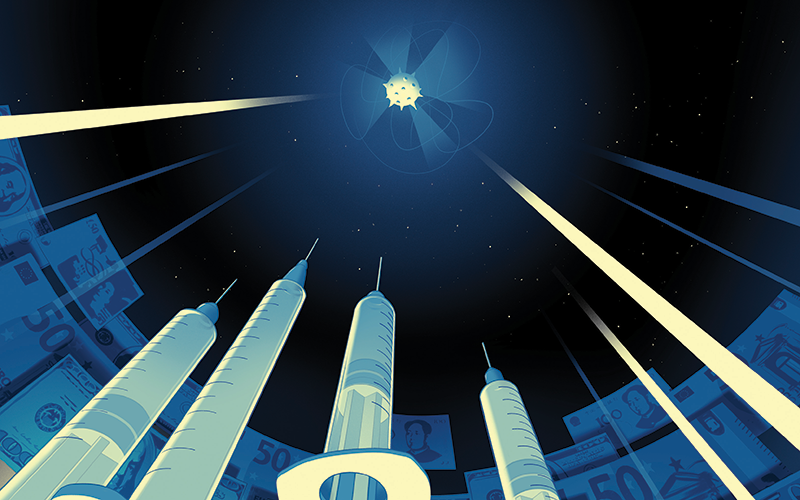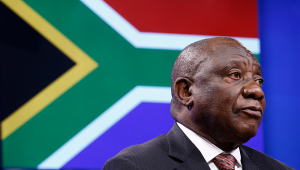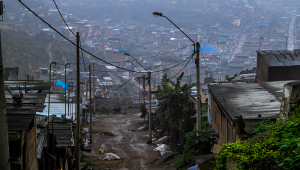web_p36-37_cover-300dpi.png

Image Credit | Senor Salme
When rampant global demand for Covid-19 vaccine collides with the reality of scarce supply, international relations come under strain. The recent spat between the UK and the European Union over vaccine supplies lays bare the political and diplomatic footwork needed to resolve what is, in truth, an inevitable shortfall in production compared with demand. In the stampede to immunise their own populations, governments have faced both practical challenges and moral dilemmas. In a world where no one is safe until everyone is, how do leaders balance enlightened self-interest against the need for equitable global access?
So far, the race to make a safe and effective vaccine has seen billions of pounds of public money poured into developing and testing potential candidates. Wealthy nations have hedged their bets on a portfolio of options, anxious to lay first claim to the most promising. Despite that public investment, vaccine pricing around the world is subject to confidential trade deals struck between pharmaceutical firms and individual countries or negotiating blocs.
The haste to secure vaccines has seen the US and some European nations contracting with manufacturers to produce doses even before clinical trials had found the drugs effective. The need for speed meant prices were negotiated without the usual analysis of cost-effectiveness. “There are certainly circumstances that might well make it appropriate not to use the usual process to evaluate prices,” says Marc Rodwin, professor at Suffolk University Law School in Boston. “However, the process used to set prices was not transparent.”
Despite this, the cost-effectiveness argument for any successful vaccine is clear cut, says John Appleby, director of research and chief economist at the Nuffield Trust. “You do not need to be a rocket scientist or an economist to work out that the benefits are going to be so big that cost-effectiveness analysis is largely pointless,” he says.
“You do not need to be a rocket scientist or an economist to work out that the benefits of any successful vaccine are going to be so big that cost-effectiveness analysis is largely pointless” - John Appleby, Nuffield Trust
Pricing deals
Pfizer, whose vaccine was first authorised by UK regulators in December, says that although the details of its deals with governments are confidential, the vaccine has been priced to ensure there are “little to no” costs for those receiving it. The company confirms that its decision-making was not driven by traditional cost-benefit analysis.
However, the differing shape of countries’ health systems plays a big role in the final size of the immunisation bill. The US will pay more for vaccines, as it lacks a national health service to negotiate pricing, according to Rodwin. “You have Medicare/Medicaid, the US Department of Veterans Affairs system, and a bunch of independent insurers negotiating rates for drugs, rather than a single government entity, which makes the US, at least thus far, unable to negotiate prices for drugs even close to those of other developed nations,” he says.
In China, too, vaccine pricing has been unclear. According to Beijing-based think-tank Anbound, disclosures from provinces suggest that prices are determined through a combination of price negotiation and bidding. Founder Chan Kung believes the current situation and the distortion of market prices is the result of “panic and political pressure”.
However, he says relatively inexpensive Chinese vaccines – currently focused on the domestic market – will also boost availability in the developing world, aiding global efforts to control the pandemic. “China may have to bear the vaccine demand of 2.5 billion people in developing countries,” he says. “Even if India exports a large amount, vaccines produced in China will inevitably occupy a good proportion of the world market.”
Affordability
Pfizer says it has introduced a tiered pricing plan, so its vaccine can be offered at a not-for-profit price to low-income countries. “Our pricing strategy is based on volume, advanced commitment, equity and affordability principles,” a spokesperson says. However, developing countries’ fragile health infrastructure has led the World Bank to approve a $12bn funding package to purchase doses, manage vaccine storage, train vaccinators and support outreach campaigns.
The global Covax initiative, set up to pool the buying power of the world’s richest and poorest nations to ensure equal access to vaccines, has also been gathering momentum. The scheme, led by the Coalition for Epidemic Preparedness Innovations (CEPI), the Gavi vaccine alliance, and the World Health Organization, aims to deliver at least two billion doses by the end of the year – enough to protect high-risk and vulnerable people, as well as frontline healthcare workers.
For countries failing to strike bilateral deals with manufacturers – and those simply unable to afford vaccines – the programme represents an essential lifeline. But it also offers a safety net for wealthier countries, both by increasing their chances of securing vital doses for their own populations, and by reducing the risk of a resurgence of the virus by ensuring that the rest of the world is also vaccinated.
There is growing concern, however, that, behind all these good intentions, progress towards the global cooperation needed to combat the virus could be sabotaged by the self-interest of richer nations. A study from Duke University’s Global Health Institute in the US predicts that limited manufacturing capacity, combined with the vast wealth disparities between nations, will put vaccination beyond the grasp of the world’s poorest countries.
“The initial research we did allowed us to identify the dangers coming and the potential crises coming, yet, over the past few months, we have not seen the gaps in vaccine equity close at all, so it actually feels like it is becoming bleaker with every week,” says Andrea Taylor, assistant director of programmes at the institute. “High-income countries really leveraged their purchasing power and their ability to make investments in vaccine development to get themselves to the front of the queue,” she adds.
Vaccine nationalism
Specifically, they could afford to risk large purchases of a range of untested vaccines – in the process, reserving most of the manufacturing slots. “They purchased so many doses, it just left empty shelves for everyone behind them,” says Taylor. While emphasising global equity and investing generously in Covax, wealthy countries were keen to maintain control of their own purchasing arrangements to ensure their own populations were vaccinated first – a phenomenon known as vaccine nationalism.
“What we saw was high-income countries treating [Covax] as a charitable mechanism,” she says. “Most said here is a lot of money, thank you very much for doing this important work, and now we will go make our own deals.” Research by Rand Europe suggests that the ‘my nation first’ approach could have catastrophic implications for both human health and world economies, with failure to allocate vaccines equitably leading to a higher global death toll, as well as potentially reducing global GDP by $1.2trn a year.
A patchwork of bilateral agreements risks adversely affecting the pricing and availability of vaccines, favouring individuals at low risk in high-income countries over those at high risk in poorer countries. “The problem with not vaccinating equitably across the globe increases the risk that new strains develop, making the vaccines in those countries that are already vaccinated less effective,” says Marco Hafner, senior economist at Rand Europe.
“This virus is extremely intelligent and is mutating quite rapidly. If you only vaccinate parts of the population, you will most likely import new strains, and, in a worst-case scenario, you could start all over again.” Investment in vaccine development and equitable access would be economically beneficial in the long run, the analysis suggests. Compared with the $25bn it is estimated to cost to supply lower-income countries with vaccine, high-income countries stand to lose a combined $119bn a year if poorer nations are denied a supply. If, on the other hand, wealthy countries agreed to fund those vaccines, they would gain back $4.80 for every dollar spent.
Pressure to share
In the meantime, pressure is growing on developed nations to share their excess vaccines. Pre-purchasing strategies, which saw the US, Canada and the EU diversify their range of vaccines, are likely to leave these countries with an oversupply of doses that cannot be stockpiled indefinitely. According to Amanda Glassman, executive vice-president of the Center for Global Development, a commitment to share vaccines with low- and middle-income countries should be a key deliverable at the meetings of G7 and D10 nations to be hosted by the UK later this year.
“International organisations could be clear on the moral and ethical imperative [of sharing] as well as the scientific imperative,” she says. Covax already has a formal mechanism for the resale, exchange and donation of vaccines, and that should be urgently brought into play. “I would like to see as much attention given to that as to fundraising for money contributions to Covax from high-income countries, because the timing matters now,” says Glassman.
“If we have all the high-efficacy candidates that are available right now, now is when it matters to share.”
The race to save lives
31 December 2019 Chinese government confirms dozens of viral pneumonia cases being treated, linked to wholesale seafood market in Wuhan
11 January 2020 First novel coronavirus genome sequence made publicly available, as China releases genome for virus SARS-CoV-2
30 January WHO declares global health emergency
17 March Pfizer and BioNTech announce initiative to co-develop vaccine
30 April AstraZeneca and University of Oxford agree vaccine collaboration
15 May US launches Operation Warp Speed to accelerate the development of vaccines
4 June AstraZeneca strikes licensing deal with the Serum Institute of India to supply one billion doses of the University of Oxford vaccine to low- and middle-income countries. Agreement also reached with CEPI and Gavi to distribute 300 million doses of the vaccine
July Pfizer and Moderna vaccines show early promise in clinical trials
12 September AstraZeneca vaccine trial resumes, having stopped after adverse reaction in patient
November Early data shows Moderna and Pfizer vaccines to be 95% effective
2 December UK regulators become first in world to grant authorisation to Pfizer vaccine for emergency use, followed by the US, Mexico, Canada and Saudi Arabia
8 December Margaret Keenan becomes first person to receive Pfizer vaccine outside trials
18 December Covax announces deals with AstraZeneca and Johnson & Johnson to bring potential number of doses secured to almost two billion
19 December Moderna vaccine approved by US regulators
30 December UK authorises AstraZeneca vaccine for emergency use, followed by Argentina
8 January UK authorises use of Moderna vaccine
13 January African Union secures 300 million vaccine doses for member states
21 January President Biden promises US will join Covax initiative
Price variations
The prices paid by different countries for Covid-19 vaccines depend on a multitude of factors – not only the negotiating clout of a nation or bloc but also contribution to research and development, the size and timing of the order, and the costs of distribution. Manufacturers may also pledge to, for example, supply vaccines on a non-profit basis to developing nations.
Of the leading vaccines, the cheapest will be the Oxford/AstraZeneca jab, with a reported price tag of $3-$4 per dose. The UK in particular will benefit from its upfront investment in the product. Although AstraZeneca has pledged not to profit from the vaccine “during the pandemic”, it is unclear how that period will be defined, and how high the price could then rise.
The vaccine developed by US biotech firm Moderna – based on pioneering mRNA technology – was initially estimated to cost up to $37 a dose. However, the US government, which pumped funding into research and development for the vaccine, is understood to have negotiated an initial price of $15, while the EU, according to leaked information, has secured a price of $18.
Meanwhile, the US government is expected to pay just under $20 a dose for the Pfizer vaccine, while the EU has agreed a price of around $15, partly thanks to German backing of Pfizer’s partner, BioNTech. Like Moderna’s, the Pfizer vaccine contains mRNA, but in lower quantities. However, the cost of the Pfizer vaccine will have to be offset against higher distribution costs, as it must be kept at -70C.













